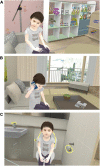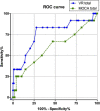Virtual reality-based monitoring test for MCI: A multicenter feasibility study
- PMID: 36741575
- PMCID: PMC9891464
- DOI: 10.3389/fpsyt.2022.1057513
Virtual reality-based monitoring test for MCI: A multicenter feasibility study
Abstract
Objectives: As the significance of the early diagnosis of mild cognitive impairment (MCI) has emerged, it is necessary to develop corresponding screening tools with high ecological validity and feasible biomarkers. Virtual reality (VR)-based cognitive assessment program, which is close to the daily life of the older adults, can be suitable screening tools for MCI with ecological validity and accessibility. Meanwhile, dehydroepiandrosterone (DHEA) has been observed at a low concentration in the older adults with dementia or cognitive decline, indicating its potential as a biomarker of MCI. This study aimed to determine the efficacy and usability of a VR cognitive assessment program and salivary DHEA for screening MCI.
Methods: The VR cognitive assessment program and the traditional Montreal Cognitive Assessment (MOCA) test were performed on 12 patients with MCI and 108 healthy older adults. The VR program operates in a situation of caring for a grandchild, and evaluates the memory, attention, visuospatial, and executive functions. An analysis of covariance (ANCOVA), a partial correlation analysis, and receiving operating characteristic (ROC) curve analysis were conducted for statistical analysis.
Results: According to the ANCOVA, no significant difference in MOCA scores was found between the normal and MCI groups (F = 2.36, p = 0.127). However, the VR total score of the MCI group was significantly lower than that of the normal group (F = 8.674, p = 0.004). There was a significant correlation between the MOCA and VR scores in the total and matched subdomain scores. The ROC curve analysis also showed a larger area under the curve (AUC) for the VR test (0.765) than for the MOCA test (0.598), and the sensitivity and specificity of the VR program were 0.833 and 0.722, respectively. Salivary DHEA was correlated with VR total (R 2 = 0.082, p = 0.01) and attention scores (R 2 = 0.086, p = 0.009).
Conclusion: The VR cognitive test was as effective as the traditional MOCA test in the MCI classification and safe enough for older adults to perform, indicating its potential as a diagnostic tool. It has also been shown that salivary DHEA can be used as a biomarker for MCI.
Keywords: DHEA; MOCA; cognitive assessment; mild cognitive impairment; screening; virtual reality.
Copyright © 2023 Jang, Choi, Son, Oh, Ha, Kim, Roh, Kim, Lee, Jung, Cha, Chae, Kang, Kwon, Kim, Lee, Shin, Ryu, Ahn, Hong and Seok.
Conflict of interest statement
J-HS was a professor at Yonsei University and the CEO of Minds.AI Co., Ltd., which was established in November 2019 as a research and development company for mental health in Republic of Korea. SJ, S-WC, I-YK, JK, J-YL, JR, and RA were employed by Research Institute of Minds.AI, Co., Ltd. HC and SK were employed by FNIKorea Co., Ltd. The remaining authors declare that the research was conducted in the absence of any commercial or financial relationships that could be construed as a potential conflict of interest.
Figures





Similar articles
-
Virtual Reality (VR)-Based Environmental Enrichment in Older Adults with Mild Cognitive Impairment (MCI) and Mild Dementia.Brain Sci. 2021 Aug 22;11(8):1103. doi: 10.3390/brainsci11081103. Brain Sci. 2021. PMID: 34439723 Free PMC article.
-
A Virtual Supermarket Program for the Screening of Mild Cognitive Impairment in Older Adults: Diagnostic Accuracy Study.JMIR Serious Games. 2021 Dec 3;9(4):e30919. doi: 10.2196/30919. JMIR Serious Games. 2021. PMID: 34870610 Free PMC article.
-
Can the Virtual Reality-Based Spatial Memory Test Better Discriminate Mild Cognitive Impairment than Neuropsychological Assessment?Int J Environ Res Public Health. 2022 Aug 12;19(16):9950. doi: 10.3390/ijerph19169950. Int J Environ Res Public Health. 2022. PMID: 36011585 Free PMC article.
-
Efficacy and Moderators of Virtual Reality for Cognitive Training in People with Dementia and Mild Cognitive Impairment: A Systematic Review and Meta-Analysis.J Alzheimers Dis. 2022;88(4):1341-1370. doi: 10.3233/JAD-210672. J Alzheimers Dis. 2022. PMID: 35811514
-
Detection of Mild Cognitive Impairment Based on Virtual Reality: A Scoping Review.Curr Alzheimer Res. 2020;17(2):126-140. doi: 10.2174/1567205017666200317100421. Curr Alzheimer Res. 2020. PMID: 32183674
Cited by
-
Combining reinforcement learning and virtual reality in mild neurocognitive impairment: a new usability assessment on patients and caregivers.Front Aging Neurosci. 2023 May 24;15:1189498. doi: 10.3389/fnagi.2023.1189498. eCollection 2023. Front Aging Neurosci. 2023. PMID: 37293666 Free PMC article. No abstract available.
-
Effects of fully immersive virtual reality training on cognitive function in patients with mild cognitive impairment: a systematic review and meta-analysis.Front Hum Neurosci. 2024 Dec 6;18:1467697. doi: 10.3389/fnhum.2024.1467697. eCollection 2024. Front Hum Neurosci. 2024. PMID: 39713172 Free PMC article.
-
Biomarkers of neurodegeneration across the Global South.Lancet Healthy Longev. 2024 Oct;5(10):100616. doi: 10.1016/S2666-7568(24)00132-6. Epub 2024 Oct 3. Lancet Healthy Longev. 2024. PMID: 39369726 Free PMC article. Review.
References
-
- American Psychiatric Association [APA]. Diagnostic and statistical manual of mental disorders: DSM-5 Vol. 5th ed. Virginia: American Psychiatric Association; (2013).
-
- Tierney MC, Szalai JP, Snow WG, Fisher RH, Nores A, Nadon G, et al. Prediction of probable Alzheimer’s disease in memory-impaired patients: a prospective longitudinal study. Neurology. (1996) 46:661–5. - PubMed
-
- Cooper C, Sommerlad A, Lyketsos CG, Livingston G. Modifiable predictors of dementia in mild cognitive impairment: a systematic review and meta-analysis. Am J Psychiatry. (2015) 172:323–34. - PubMed
-
- Petersen R, Smith G, Waring S, Ivnik R, Tangalos E, Kokmen E. Mild cognitive impairment: clinical characterization and outcome. Arch Neurol. (1999) 56:303–8. - PubMed
LinkOut - more resources
Full Text Sources
Research Materials

